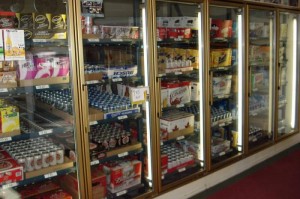 To mark the 20th anniversary of the Alberta government’s decision to privatize liquor distribution and retail, the Edmonton Journal ran a three-part series examining its effects. The first part (found here) offered a general evaluation, the second was an interview with the Minister responsible for the scheme (here), and the final installment was a series of three profiles on successful liquor store operators, including the big chains (here, here and here). There were also some sidebars, but I will let you find them for yourself.
To mark the 20th anniversary of the Alberta government’s decision to privatize liquor distribution and retail, the Edmonton Journal ran a three-part series examining its effects. The first part (found here) offered a general evaluation, the second was an interview with the Minister responsible for the scheme (here), and the final installment was a series of three profiles on successful liquor store operators, including the big chains (here, here and here). There were also some sidebars, but I will let you find them for yourself.
I believe the series is mostly a missed opportunity. Rather than do any research or investigation, the Journal decided to combine a traditional “talking heads” piece, where they interview a few people from different perspectives and weave together a story, with fluff profiles and an extended rant from the man responsible. The result is disappointingly predictable. Of course three successful liquor operators and the man who came up with the idea are going to say privatization is a success. How could we expect otherwise? The series is remarkably incomplete.
The first part teases at some questions about the outcomes around pricing and unfair advantages for big players but never really probes the substance of the issue. The interview with Steve West simply reminds me that he is a nasty, disagreeable ideologue. It tells us nothing about the outcomes of the policy and simply gives him a bully pulpit to bash unions and slag people who disagree with him. The third part has some interesting human elements, but reads as light as air.
I have used this website in the past to try to take a serious look at the consequences of Alberta’s private liquor retail, including a multi-part series carefully dissecting the system from multiple perspectives (I am feeling too lazy to offer links to the half dozen or so posts I have done on the topic, so if you are interested, just type “privatization” into the search bar above). I won’t repeat myself here, but instead I want to offer some unsolicited (and likely unwanted) assistance to any journalist or policy analyst who wishes to evaluate the effects of liquor privatization in Alberta. See it is a something of a guide to researching liquor privatization.
- The price question, while complex (e.g., differing taxation levels), is mostly resolved. Every study (that I have seen) which uses rigorous methods to compare finds Alberta to have higher average prices. Contradictory examples will always be present, but they don’t tell us about the big picture.
- Selection is not just about how many SKUs (stock keeping units) are available in the province. Alberta is the hands down winner in that category. The more relevant question is how many of those products are reasonably accessible to the average consumer? If you have to drive half way across the city to get your favourite product, is that improved selection? And what about rural residents, where there may be no reasonable options?
- Remember that liquor retail and import policy are separate issues. While the Alberta government adopted an open border policy for liquor at the same time as it privatized retail, the two do not necessarily go hand in hand. One can occur without the other. We need to ask which has been more important for the expanded number of SKUs?
- Consumers are important, but they are not the only affected party. Any analysis should also examine how privatization affects producers (i.e., breweries), agents and the broader community. For example, how have Alberta breweries been affected by privatization (my answer: their life is harder)? Or, is having liquor stores open to 2 a.m. really a good thing?
- Don’t lose sight that power differences still exist. Liquor Stores NA (Liquor Depot) benefits disproportionately from the system than a small mom-and-pop shop, just like Molson and Labatt benefit more than Alley Kat or Wild Rose. In every policy change there are winners and losers. Highlighting just the winners presents a skewed view.
- Remember that not just retail was privatized. The government also created a private monopoly for distribution. How does that affect the system?
- Consider broader economic and social effects. What are the consequences of turning $16-an-hour jobs (in 1993 dollars) into minimum wage jobs? What effect might private stores have on under-age drinking?
- Finally, keep your eye on the public interest. After all, that is what all public policy is supposed to be designed to address. Is the general public benefiting? I know that is a difficult concept to pin down, but it might help anchor our discussions around privatization and liquor in general.
I suspect that anyone who follows these suggestions will find that the answer is very complex and complicated. It may not be convenient when you only have so many column inches for your article, but it will be a more accurate reflection of the reality of liquor privatization in Alberta.

August 28, 2013 at 12:06 PM
Zing! The interview of Steve West was particular uninformative and most of his assertions went unchallenged. I know the Journal has been hit hard by cutbacks but, overall its news coverage seems to be in a death spiral.